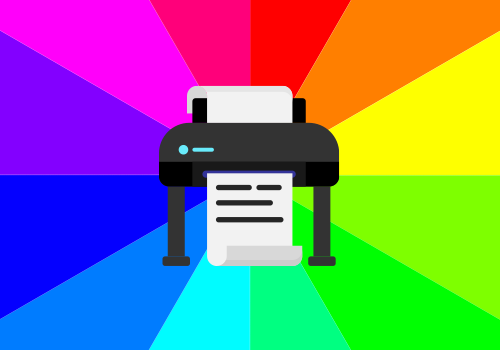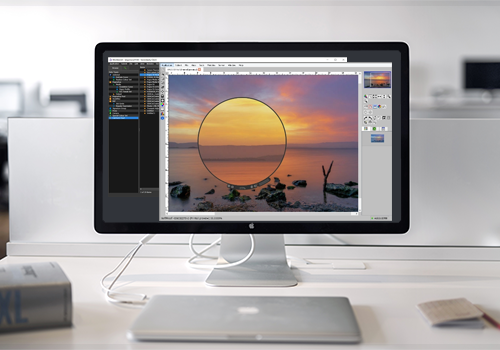Introducing Colour-Managed RIP Software: What it is and Why You Need it
Colour management is an important aspect of modern printing and digital imaging. It ensures that image colours are accurately reproduced on various devices such as printers and monitors. Colour management can be a complex and difficult process, but with the help of RIP software, it can be made much easier.
Colour speaks a universal language, driving industries from design to packaging; and in a world driven by visual excellence, colour management stands as a crucial pillar across these diverse industries. Imagine a digital masterpiece crafted with meticulous care, only for its printed counterpart to fall short. This disconnect between digital design and physical output has fuelled the need for a bridge – a way to seamlessly transform digital precision into reality.
This is where colour-managed RIP Software steps in. It's no longer about approximations; customers expect on-screen hues to faithfully adorn canvas, packaging, or fabric. This software isn't just a tool; it's the key to unlocking the potential of colour in the digital-to-physical translation. In this article, we will unveil the software's mechanisms, benefits, and impact, guiding readers through a world of elevated colour accuracy.
What is RIP Software?
RIP (Raster Image Processor) software acts as an intermediary between digital designs and physical print output. It translates intricate digital data, including colours, gradients, and nuances, into a format that printing hardware can faithfully reproduce. One might wonder, why is this translation process even necessary? Can't the printer interpret the digital data on its own? While modern printers are efficient, they lack the specialised processing needed for accurate rendering of complex designs.
This is where RIP Software steps in to fulfil this critical role. It processes intricate digital design data, interprets colour information, and converts it into instructions for the printer. This encompasses colour conversion and screening, ensuring precise colour reproduction. RIP software also offers enhanced control, allowing users to fine-tune colour profiles, rendering intents, and ink usage for accurate results, especially in commercial printing.
In essence, RIP software transforms digital designs into print-ready formats, maintaining colour fidelity. It bridges the gap between creative vision and final printed output, offering control and accuracy. Understanding its technical operations and algorithms unveils the essence of colour-managed RIP software's role in the printing process.

How does RIP Software Work?
The workings of colour-managed RIP software might seem like some sort of wizardry, but beneath its complex surface lies a systematic process that ensures accurate colour representation and faithful reproduction. It achieves this through several key steps:
Colour Conversion: At the core of RIP software's operation is the task of colour conversion. This step involves translating the colour information embedded in the digital design into a format that is compatible with the printing hardware's CMYK (Cyan, Magenta, Yellow, Key/Black) colour space. This conversion is crucial because the range of colours achievable in the digital world differs from that in the physical printing realm.
Screening: Once the colour conversion is complete, RIP software engages in rasterising – a process that transforms images into pixels that printers can reproduce. This technique is essential to replicate gradients and achieve a perception of continuous tone despite the printer's ability to produce only discrete dots.
Rendering Intents: Different designs demand different rendering intents to ensure optimal colour representation. RIP software provides options like perceptual, relative colourimetric, absolute colourimetric, and saturation rendering intents. These intents determine how out-of-gamut colours (colours that can't be faithfully reproduced by the printer) are managed during the conversion process, ensuring that the final print remains as close as possible to the original design's colour intent.
Colour Management Algorithms: Behind the scenes, RIP software employs a range of sophisticated algorithms to achieve accurate colour reproduction. These algorithms consider factors such as colour gamut (the range of colours a device can reproduce), colour profiles (describing the colour behaviour of devices), and ink limits. The software intelligently adjusts colours to match the printer's capabilities while preserving the overall visual harmony.
Printer Linearisation: Printers don't always produce colours linearly. RIP software includes linearisation processes that calibrate the printer's colour output to ensure a consistent and predictable relationship between input and output data. This step is crucial to achieving reliable and repeatable colour results.
Data Compression: Digital designs can be incredibly detailed and intricate, resulting in large file sizes. RIP software optimises these files for printing by compressing data without compromising on colour accuracy. This compression streamlines the printing process, enabling efficient data transfer from the software to the printer.
In summary, RIP software orchestrates various processes to accurately translate digital design into printed output. From colour conversion to algorithms, each step harmonises design and print, revolutionising colour accuracy across industries.
Unveiling the Core Features
RIP software is a feature-rich tool that enhances colour accuracy in digital-to-physical translation.
Here are its essential features:
ICC Profiles and Calibration: RIP software utilises ICC profiles to maintain colour consistency across devices like monitors and printers, leading to reliable and predictable colour outcomes. The software not only applies these profiles but also manages the calibration of the printing hardware to match the industry-standard colour spaces, like sRGB or AdobeRGB, Fogra 39 or GRACol.
Colour and Gamut Mapping: RIP software employs advanced techniques to ensure accurate and vibrant colours on any output device. For instance, when a vibrant design is sent to a CMYK printer, the software adjusts colours to fit within the printer's gamut while preserving the design's visual integrity.
Enhanced Rendering Options: RIP software offers a range of rendering intents to suit varied outputs such as fine art, photography, and packaging, preserving colour intent across mediums. Each rendering intent serves a unique purpose:
- Perceptual: Prioritises the overall visual appearance of colours, adjusting the entire colour gamut to fit within the destination colour space while preserving the perceived relationships between colours.
- Relative Colourimetric: Maps the white point of the source colour space to the white point of the destination colour space. Colours that fall within the gamut of the destination space remain unchanged. Out-of-gamut colours are shifted to the nearest reproducible colour within the destination gamut.
- Absolute Colourimetric: The white point of the source colour space is mapped directly to the white point of the destination colour space. Colours that fall within the gamut of the destination space remain unchanged. However, out-of-gamut colours are clipped to the closest reproducible colour within the destination gamut, potentially leading to a loss of detail in highly saturated colours.
- Saturation: Adjusts the saturation levels of colours to fit within the gamut of the destination colour space. Colours that are out of gamut are modified to be more or less saturated, depending on their position in the colour space. The aim is to achieve a visually pleasing result by emphasising the overall intensity of colours.
Customisable Ink Control: RIP software enables precise ink control for cost-efficient and eco-friendly printing. It's invaluable in large-scale print shops, where it minimises ink usage, lowers costs, and promotes environmental sustainability.
White Ink and Spot Colour: RIP software enables precise reproduction of white ink and spot colours, crucial for industries like packaging and textiles.
Colour Verification and Soft Proofing: RIP software often includes tools to preview final print colours, helping to catch any discrepancies early and ensuring desired colour accuracy.
In the dynamic field of colour management, RIP software stands out with versatile features. From utilising ICC profiles to specialised ink control, these tools empower professionals to maintain envisioned colours accurately during the design-to-print transition.
Advantages of RIP Software
RIP software offers many advantages for digital printing and imaging, including:
Precise Colour Control: The software's sophisticated algorithms and calibration processes ensure that colours remain consistent and accurate across a range of output devices – from monitors to printers.Cost Reduction: Ink is a valuable resource in the printing process, and wasted ink translates to unnecessary costs. RIP software's ink control features enable designers to optimise ink usage, reducing waste and lowering printing costs. By calculating and adjusting ink limits intelligently, the software ensures that vibrant colours are achieved without over-saturation. Efficient job nesting is another essential aspect of cost reduction. RIP software's ability to intelligently arrange print jobs on media also helps save money and reduce media wastage.
Enhanced Productivity: Colour discrepancies between design and print can lead to time-consuming and costly rework. RIP software eliminates this need for trial and error by ensuring that what you see on screen is accurately reproduced in print. This accuracy translates to increased productivity, as professionals can confidently move forward with projects without the fear of unexpected colour surprises.

Expanded Creativity: The ability to fine-tune rendering intents, control inks, and manage spot colours opens doors to new possibilities in design. From achieving subtle gradients to handling complex colour combinations, RIP software empowers designers to push the boundaries of colour creativity.
Consistency Across Different Print Runs: Whether it's a batch of marketing materials, photographic prints, or textiles, maintaining consistent colour representation across different print runs is crucial. RIP software's calibration and profiling ensure that colours remain stable over time, eliminating the need to continually adjust colour settings for each print job. This consistency reinforces brand identity and professionalism.
Higher Quality, Greater Efficiency: RIP software elevates overall print quality. By mitigating issues like banding and colour crossover, the software delivers prints with smoother transitions and finer details. Moreover, it does so with greater efficiency, minimising the need for manual adjustments and saving valuable time.
In a visually-driven world, colour-managed RIP software goes beyond colour accuracy. It empowers professionals to execute creative visions, optimise resources, and elevate output quality.
Seamless Integration into Workflows
Embracing new technology often raises concerns about disruption to established workflows. However, integrating RIP Software into your existing design and printing processes doesn't have to be a daunting task. In fact, it can enhance efficiency and reduce the need for manual colour adjustments.
Here are a few examples of where RIP software might fit into an existing workflow.
Photographic Workflow
- Image Capture/Import: Photographs are taken with cameras or imported from external sources.
- Image Editing: The images are then edited using software like Adobe Photoshop or other image editing tools. This involves adjustments for colour correction, retouching, cropping, and other enhancements. Colour profiles are assigned to the images to ensure accurate colour representation across different devices and media. In some cases, images might be integrated into designs or layouts, such as for posters or magazines.
- RIP Software: The processed images are sent to the RIP software. The RIP software is responsible for translating the high-resolution image data and colour information into a format that can be understood by the specific output device, such as a printer or a large-format printing press.
- Output Device: The RIP-processed data is sent to the output device, which could be a high-quality printer, a large-format printing press, or other devices capable of reproducing images onto physical media. The output device uses the processed data to create a physical print. The RIP software ensures that colour accuracy, resolution, and other print settings are optimised for the specific output device.
- Quality Control: The printed output is inspected for colour accuracy, sharpness, and other quality factors. Adjustments may be made if necessary.
- Final Product: The high-quality, accurately coloured prints are the final products of the photographic workflow.
Advertising Agency Workflow
- Design and Layout: Creative teams use graphic design software to create visual materials like advertisements, brochures, and banners.
- File Preparation: Finalised designs undergo preparation, ensuring correct colour spaces, embedded fonts, and flattened transparencies for printing.
- RIP Software: Design files are sent to RIP software, converting vector graphics and text into printable raster images with accurate colour reproduction.
- Image Processing: RIP software handles complex tasks like colour separation, rasterisation, and screening, optimising images for specific output devices.
- Print Layout: Depending on the job, RIP software may arrange multiple images on a single print sheet (imposition/nesting), ensuring efficient paper usage.
- Output to Printer: Processed raster data is sent to the chosen output device (printer, digital press, plotter) with instructions for accurate printing.
- Colour Calibration and Profiling: High-quality RIP software can also manage colour calibration and profiling of the output device. This ensures consistent and accurate colour reproduction across different print jobs and devices.
- Print Production: The output device produces the final printed material based on raster data generated by the RIP software, aligning with the creative team's vision.
Offset Print Proofing Workflow
- Design & File Preparation: Graphic design software is used to create tailored materials such as brochures or packaging designs. Final designs undergo preparation, including colour space verification, font embedding, and transparency flattening.
- Prepress and Imposition: Perform trapping to prevent colour misregistration and unwanted gaps between colours. Arrange pages efficiently on printing plates using imposition to optimise paper usage.
- Platesetter RIP (CTP): Convert the digital design files into raster images. Separate the design into individual colour channels (CMYK). Apply screening techniques to modulate dot size and density. Generate halftone dots to represent different shades of colours.
- Plate Production: Expose light-sensitive material on aluminium plates using the platesetter. Develop the exposed plates to create printing plates.
- RIP Software: Import the plate files created by the platesetter RIP and recombine them into the colour job. Apply colour management to match the press colour profile. Arrange pages efficiently on printing plates using imposition. Preserve the halftone dot structure generated by the platesetter RIP to ensure consistent colour and image quality.
- Proofing: Generate a proof using a digital proofer or printer. Review the proof for colour accuracy, image quality, layout errors, and consistency with the original design. Make any necessary corrections to the design or files.
- Printing Production: Mount the approved printing plates on the offset press. Print the final product, aligning with the approved design and colour specifications.
The integration of colour-managed RIP software need not disrupt your established workflows. On the contrary, it enhances your operations by automating colour translation, reducing manual adjustments, and boosting overall efficiency. By following best practices, and leveraging the software's features, you can seamlessly incorporate RIP software into your existing processes and reap the benefits of elevated colour accuracy without unnecessary disruption.
Choosing the Right RIP Software
Selecting the most suitable colour-managed RIP software is a decision that warrants careful consideration. With a range of options available, it's essential to evaluate features, compatibility, support, and scalability to make an informed choice. Factors to consider include:
Feature Set: Different RIP software packages offer varying features. Assess your requirements and prioritise features that align with your workflow and goals. Look for features like media calibration, rendering intents, ink optimisation, and compatibility with your output devices.
Compatibility: Ensure that the software is compatible with your design software, printers, and other devices in your workflow. Seamless integration is essential to avoid compatibility issues that could disrupt your processes.
Colour Accuracy: Look for software that emphasises accurate colour reproduction. Consider software that offers advanced colour mapping and gamut mapping techniques to ensure that colours remain true to your design intent.
Ease of Use: User-friendliness matters. A software with an intuitive interface and clear documentation can accelerate the learning curve and minimise downtime during integration.
Support and Updates: Reliable customer support is crucial. Choose a provider that offers timely assistance and regular updates to address potential issues and incorporate new features.
Scalability: Consider the future growth of your projects and business. Choose software that can accommodate your expanding needs and adapt to changes in technology and workflow.
Trial Period: Many software providers offer trial periods. Take advantage of these trials to explore the software's features, user interface, and compatibility with your workflow.
The choice of colour-managed RIP software is a pivotal decision that can significantly impact your colour accuracy, efficiency, and overall print quality. By considering factors such as features, compatibility, support, and scalability, you can select a software solution that aligns seamlessly with your workflow and goals.
Precision Unleashed
Colour-managed RIP software is a crucial tool in achieving precision and consistency in conveying messages, evoking emotions, and establishing brand identities through colour. It serves as a guide, ensuring unparalleled accuracy in the transition from digital pixels to tangible prints. It bridges design software and printing hardware, enabling seamless colour conversion, rasterising, screening, and rendering intents.
RIP software transforms industries. It ensures consistent brand representation, enhances photographic prints, and elevates textile designs. It eliminates compromise between design intent and printed output, translating artistic vision into vibrant reality.
The message is clear: embracing RIP software is not a matter of "if," but "when."



